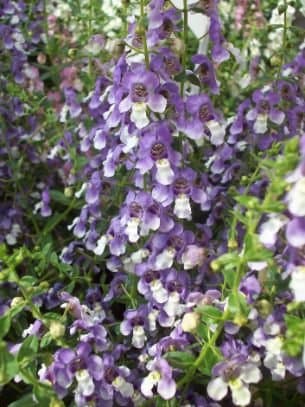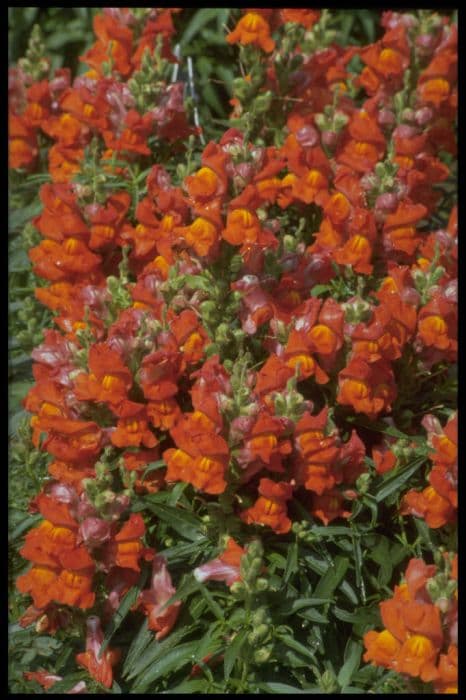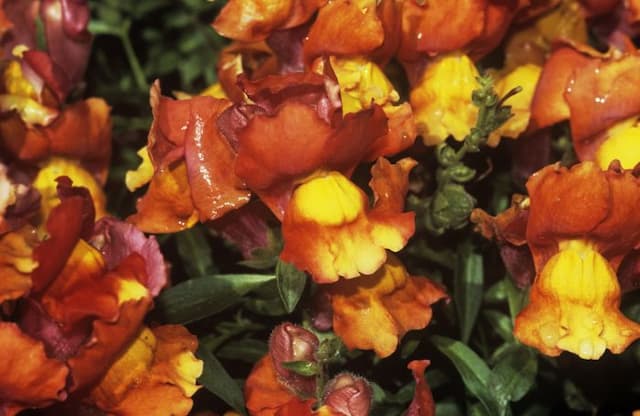Beardtongue Penstemon 'Pennington Gem'

ABOUT
Penstemon 'Pennington Gem', often referred to simply as Penstemon, boasts an impressive display of narrow tubular flowers that come in a mix of pink and purple hues, known to attract hummingbirds and other pollinators. The blooms are arranged densely on tall spikes that rise well above the foliage, creating a vivid and eye-catching display. The leaves of this plant are lance-shaped, somewhat glossy, and present a rich green color that provides a lovely contrast to the vibrant blooms. The flowering spikes and leaves collectively give Penstemon 'Pennington Gem' a bushy and lush appearance, contributing to its popularity in garden beds and borders where it's admired for its ornamental qualities.
About this plant
 Names
NamesSynonyms
Pennington Gem Beardtongue, Pennington Gem Penstemon.
Common names
Penstemon 'Pennington Gem'.
 Toxicity
ToxicityTo humans
Beardtongue (the common name for Penstemon) is generally considered non-toxic to humans. There is no widespread documentation of poisoning or significant toxic effects from ingesting parts of the plant. However, as with any non-food plant, individuals may have varying sensitivities and possible mild stomach upset might occur if ingested in large quantities. It is always best to discourage consumption of ornamental plants and to monitor young children and pets around them.
To pets
Beardtongue is generally not considered toxic to pets such as dogs and cats. There are no well-documented cases of poisoning in pets from consuming this plant. Most pets should be able to ingest small amounts of this plant without any significant adverse effects. However, it is still prudent to prevent pets from eating ornamental plants as a precaution, and to monitor for any signs of gastrointestinal upset or unusual behavior if they do consume any part of the plant.
 Characteristics
CharacteristicsLife cycle
Perennials
Foliage type
Deciduous
Color of leaves
Green
Flower color
Pink
Height
2-3 feet (60-90 cm)
Spread
1-2 feet (30-60 cm)
Plant type
Herb
Hardiness zones
5
Native area
North America
Benefits
 General Benefits
General Benefits- Attracts Pollinators: The vivid flowers are a magnet for bees and hummingbirds, which helps with pollination of your garden plants.
- Drought Tolerance: Once established, Penstemon 'Pennington Gem' is quite drought-resistant, making it suitable for water-wise gardens.
- Low Maintenance: It requires minimal care once established, which is ideal for busy gardeners or those looking for lower-maintenance landscapes.
- Decorative Uses: The striking flowers and foliage can be used in cut flower arrangements or as garden ornamentals.
- Adaptable: It can thrive in a range of soil conditions, which makes it a versatile choice for various garden settings.
- Seasonal Interest: Blooms from late spring to early summer, providing color during times when many other plants are not in peak display.
- Native Plant Benefits: As a plant native to North America, it supports local ecosystems and wildlife.
 Medical Properties
Medical PropertiesThis plant is not used for medical purposes.
 Air-purifying Qualities
Air-purifying QualitiesThis plant is not specifically known for air purifying qualities.
 Other Uses
Other Uses- Hummingbird attractor: Penstemon is particularly appealing to hummingbirds due to its tubular flowers, making it an ideal plant to encourage wildlife in a garden.
- Butterfly garden addition: The nectar-rich flowers of Penstemon can also help attract and support butterflies, which adds to the biodiversity and beauty of garden spaces.
- Erosion control: The fibrous roots of Penstemon help stabilize soil and can be used on slopes or areas prone to erosion to hold the soil in place.
- Education and research: Penstemon species can be used in educational settings to teach about pollination, plant adaptation, and native flora.
- Photography subject: The striking flowers of Penstemon make it a popular subject for botanical photographers and hobbyist garden photographers.
- Culinary garnish: Though not commonly consumed, the blooms of Penstemon can be used as an edible garnish to add color to salads or desserts (make sure they're free of pesticides and grown organically).
- Drought-tolerant landscaping: Being drought-resistant, Penstemon is ideal for xeriscaping and reducing water use in landscaping.
- Seasonal interest: Penstemon can add color and interest to a garden during its blooming season, and its persistent seed heads can provide visual interest even after flowering.
- Floral arrangements: Cut flowers from Penstemon can be used in fresh bouquets and floral arrangements to add a natural, wildflower look.
- Seed harvesting: Gardeners can harvest seeds from Penstemon to propagate new plants or to share with other gardening enthusiasts.
Interesting Facts
 Feng Shui
Feng ShuiThe Penstemon is not used in Feng Shui practice.
 Zodiac Sign Compitability
Zodiac Sign CompitabilityThe Penstemon is not used in astrology practice.
 Plant Symbolism
Plant Symbolism- Attraction: Penstemon, often referred to as Beardtongue due to the hairy texture inside the flowers, has tubular blossoms which attract bees and hummingbirds. Its symbolism of attraction extends to the idea of pulling in good energy and positive influences.
- Endurance: Beardtongue plants are resilient and capable of withstanding various climatic conditions. They symbolize the ability to endure difficulties and adapt to different environments.
- Boldness: The Penstemon 'Pennington Gem', with its vivid colors and striking presence, embodies boldness and the courage to stand out.
- Diversity: There are many different varieties of Penstemon showcasing various colors and shapes. This diversity is symbolic of the beauty of variety and embracing differences.
 Water
WaterBeardtongue should be watered deeply once a week, allowing the soil to dry out slightly between waterings. During the hotter summer months, you may need to water more frequently to maintain consistent moisture, especially for plants in containers. Generally, applying about one gallon of water per plant each week should be sufficient, but adjust according to the weather conditions and the plant's response. Overhead watering is not recommended as it can promote fungal diseases; instead, water at the base of the plant to keep the foliage dry.
 Light
LightBeardtongue thrives best in full sunlight conditions, requiring at least six hours of direct sunlight every day. Plant your Beardtongue in a spot where it can receive ample morning sunlight and partial shade in the afternoon during the hottest part of the day, especially in regions with intense sun. Avoid placing it in deep shade, as this will reduce flowering and can lead to leggy growth.
 Temperature
TemperatureBeardtongue prefers a temperate climate with temperatures ranging between 50°F and 85°F for optimal growth. The plant can tolerate temperatures down to about 20°F but should be protected or mulched during colder winters to ensure survival. Consistently maintaining temperatures within the stated range will encourage healthy growth and flowering in Beardtongue plants.
 Pruning
PruningPruning Beardtongue is important for maintaining a neat appearance and promoting vigorous growth and flowering. After the initial spring bloom, deadhead spent flowers to encourage a second bloom in the season. Prune back the plant by about one-third in late winter or early spring before new growth starts, which helps prevent woodiness and stimulates new, lush growth. Pruning at this time also allows for quick recovery during the growing season.
 Cleaning
CleaningAs needed
 Soil
SoilBeardtongue thrives in well-draining, loamy soil with a pH ranging from slightly acidic to neutral. To create the best soil mix, combine equal parts of garden soil, coarse sand, and peat or compost to enhance drainage and fertility. Mulch can be added to help retain moisture and regulate soil temperature.
 Repotting
RepottingBeardtongue generally does not require frequent repotting and can often be left undisturbed for several years. Repotting every 3-5 years, or when it becomes root-bound, is typically sufficient for maintaining its health and vigor.
 Humidity & Misting
Humidity & MistingBeardtongue prefers moderate humidity levels but is quite adaptable to different conditions. It tolerates dry air well and does not require any special humidity considerations, making it suitable for typical outdoor environments where the plant is commonly grown.
 Suitable locations
Suitable locationsIndoor
Provide bright light, minimal water, and good drainage.
Outdoor
Full sun, well-draining soil, and minimal watering.
Hardiness zone
4-9 USDA
 Life cycle
Life cyclePenstemon 'Pennington Gem' begins its life cycle as a dormant seed, typically requiring a period of cold stratification to simulate winter conditions before germination. Upon exposure to favorable spring temperatures and moisture levels, the seed germinates, developing into a seedling with both roots and leaves for photosynthesis. As the plant enters the vegetative stage, it establishes a robust root system and produces a rosette of leaves, followed by elongated stems. Flowering occurs in the next stage, usually in late spring to early summer, with the plant showcasing tubular, vibrantly colored flowers that attract pollinators. After pollination, flowers give way to seed capsules containing numerous small seeds, completing the reproductive cycle. In the final stage, the plant enters dormancy during winter, conserving energy until the onset of the next favorable growth period.
 Propogation
PropogationPropogation time
Spring-Early Summer
The Penstemon 'Pennington Gem', commonly known as beardtongue, is typically propagated by seeds or cuttings. However, the most popular method of propagation for this perennial is through cuttings, specifically softwood cuttings that are taken in late spring or early summer. To propagate by cuttings, one would choose a healthy, non-flowering stem and make a cut of about 4 to 6 inches (10 to 15 centimeters) in length, just below a node. The lower leaves are then removed, and the cut end may be dipped in rooting hormone before being placed into a well-draining potting mix. The cutting should then be kept in a warm, humid environment with indirect sunlight until roots develop, which usually occurs in a few weeks. Once rooted, the new plant can be transplanted into the garden.









